To say the marketing technology landscape is crowded would be an understatement. A CMO’s job is tough enough without having to choose among 1,400 digital marketing tools to create the perfect marketing tech stack. According to research by the Winterberry Group, the average marketer uses 12 different martech tools and desperately wishes they integrated more seamlessly with each other.
That’s a lot of technology to manage. Obviously, no marketer can have it all, so which tools are truly worth the investment?
Take a Step Back And Survey Your Stack
If you wake up to an inbox full of cold emails from marketing technology vendors every day, this article is for you. If you’re running a shoestring budget and agonize over which marketing tools to keep and which to let go, this article is for you. If your budget is boundless (lucky!) and your CEO gets excited about the potential of every new, shiny marketing technology, this article is for you.
Let’s get back to basics. Here, we’ll talk about the 10 indispensable tools every business should keep in their marketing tech stack. These technologies will form the foundation of your digital marketing arsenal — once you master them, every other martech tool is just icing on the cake.
1. Google Analytics: how are users and customers interacting with your website?

Google Analytics is the granddaddy of data-driven digital marketing. It almost seems too obvious to include on this list, but that’s the beauty of it — provided you know how to use Google Analytics to its full potential, you can save yourself the expense of other, more expensive analytics dashboards.
Of course, if you’re not using Google Analytics to its full potential, you can always stop by Google Analytics Academy to learn how to customize your dashboard and map out your user journey from top-funnel visitors to bottom-funnel, ready-to-convert customers. By tracking the way users find and interact with your website, you can make changes to your marketing strategy that turn your website into your highest-performing sales asset.
The magic of Analytics, of course, is its seamless integration with other digital marketing products in the Google ecosystem. By linking your Google Analytics account with AdWords, you can see how many user interactions on your site began with a specific ad you’re running, import your ecommerce transactions and Analytics goals to AdWords, and gain total visibility into the customer lifecycle from the first ad impression to closing the sale.
2. A content management system (CMS) built with SEO in mind.
Gone are the days of having to phone your most talented developer every time you needed to make a copy update to your website. Today’s CMS platforms are designed for ease of use, so marketing managers don’t have to bone up on HTML and CSS to create or edit pages — they can simply fire up a template, upload their assets, add their content, and optimize to perfection.
HubSpot is certainly a great choice for this if it fits your needs, but it might not be the best option for your particular business. WordPress offers similar marketing functionality a la carte through plugins like Yoast SEO and MailChimp, at a much more manageable price point. Both platforms are built with digital marketing and SEO in mind, so you don’t have to do a ton of backend configuration to get on the front page of Google. All you need is a slam-dunk strategy and plenty of keyword research, which brings us to…
3. An SEO auditing and keyword research platform.

Even if you build your website on a platform designed for digital marketing awesomeness, you could still have some loose ends keeping you from getting the organic search traffic you deserve. An SEO auditing tool like SEMrush, Ahrefs, or Screaming Frog can tell you if issues like page speed, 404 errors, long page titles, missing meta descriptions, or images without alt text are harming your search performance.
The advantage of SEMrush and Ahrefs is they perform double duty: not only will they produce SEO audit reports, but they’ll guide you to the right keywords to target when optimizing your site for organic search. SEMrush even comes with a Google Docs extension that grades your SEO best practices as you write, recommending keywords you may not have thought of and suggesting backlink opportunities based on your content.
4. An email marketing platform with personalization and automation.
Of all the ways to reach customers and potential customers, email marketing is one of the most valuable, with a 122% median ROI. That number can climb much higher if you segment your email lists by customer interest, behavior, and position in the marketing and sales lifecycle, and use automation to reach each lead with personalized content at the right time.
Whether you’re using an email marketing platform like MailChimp or the email functionality of marketing automation platforms like HubSpot or Pardot, make sure email has a cherished spot in your marketing tech stack — segmented email campaigns generate 14% more opens and 100% more clicks than non-segmented campaigns.
5. A social media scheduling and management platform.
If you had to manually tweet or write a Facebook post for every industry headline you thought would resonate with your audience in real-time, you — well, you’d probably have a pretty powerful social media presence, but who has time (or budget) for that?
A social media platform like Buffer, Hootsuite, or Crowdfire saves you precious time by allowing you to schedule evergreen social posts to populate your feed while you focus on other marketing tasks. Hootsuite also adds value to your martech stack by giving you an ear on the inside. Its social listening functionality lets you monitor your brand reputation (and your competitors) online, while gathering valuable analytics to inform your social media strategy.
You should still pop into your social media accounts at least once per day to engage with followers and share more time-sensitive content, but a social scheduler is still a marketing lifesaver.
6. A customer relationship management (CRM) solution with sales and marketing integration.
Sales and marketing are like diet and exercise — you need to align both on the same goal to achieve the results you want. To do that, you need plenty of collaboration, open lines of communication between teams, and a good customer relationship management solution.
Which CRM software is right for your business goals? Salesforce is a popular choice for its robust features, while HubSpot has the advantage of wearing many hats as an inbound marketing platform with CMS and CRM capabilities. Of course, we’re quite partial to striven, which integrates CRM, project management, accounting, and human resources software into a single system that powers your entire business.
While not strictly a marketing technology, your CRM is one of the most critical software investments your company makes, so it’s important to make your voice heard and ensure your marketing needs factor into the software selection process.
7. A photo editing and graphic design tool.
A picture says a thousand words, and visual content drives more engagement than mere copy — provided it looks good. This makes graphic design software like the Adobe Creative Suite (or its open source alternatives) a marketing technology must-have.
With that said, not every marketer doubles as a digital designer, so it helps to add a service like Canva to your marketing tech stack. Canva provides hundreds of free templates for social media graphics (with up-to-date specs), infographics, print graphics, and nearly anything you need to make your brand sing. (Want some motion graphics? Read our post on how to make a GIF like a pro!)

8. PPC advertising: Google AdWords, Bing Ads, and social media advertising.
Once you make those outstanding graphics, you can use them in digital advertising! Paid advertising on platforms like Google Adwords, Bing Ads, Facebook, Twitter, LinkedIn, and Pinterest allow you to get your message in front of the audience most likely to engage, with granular targeting options spanning broad demographics and interest-based ad targeting.
We’re filing all of these platforms under one category — pay-per-click advertising — because no single PPC ad platform (even Google AdWords) will guarantee the best results for your brand. When it comes to PPC, you can’t put all your marketing eggs in one basket. To determine which networks are best for promoting your ads, it’s worth testing a few, measuring ROI, and adjusting your strategy and budget accordingly.
9. An A/B testing, heatmapping, and session recording tool.
While setting up your Google Analytics dashboard is a necessary starting point for tracking user behavior, it doesn’t give you the granular detail you need to make the biggest impact on your website performance. For that, you need a platform for heatmapping, A/B testing, and session recording, like FreshMarketer (one of our favorites!) or Google Optimize.
By watching session recordings and analyzing heatmaps, you can hypothesize changes that optimize conversions — for example, changing CTA appearance or tweaking your copy — then create experiments that compare those changes against the original build. Simply by A/B testing a new button color, the Miles Digital Marketing Team was able to help a national healthcare franchise gain 1,900% more clicks on a contact form in just four months!
10. A good old-fashioned whiteboard.
Marketing technology has come a long way, but one thing it still can’t do is create awesome ideas. That’s up to you and your team, and sometimes, you still need to step away from the screen, gather around a whiteboard, and brainstorm. The freeform expression that blank canvas facilitates, combined with great conversation and debate, is where your “Think Different” or “Just Do It” moment happens.
The Best Marketing Investment is an Agency Partner Like Miles
Even when narrowed down to a list of ten categories, the marketing technology options out there can overwhelm even the most battle-tested CMOs. After you’ve assembled the ideal marketing tech stack to carry out your finely honed strategy, it’s natural to ask yourself, “What now?”
Miles IT has helped countless businesses achieve their digital marketing goals with a combination of website design and development, search engine optimization, PPC advertising, content marketing, social media marketing, email automation, persona research, messaging strategy, and more.




Good and helpful tools. Every marketing person should know about these tools. As a digital marketer, I have learned new tools here in this post.
Really this is very nice blog thanks for sharing with us your information..
I used to use Divi but started to use Elementor and Astra through your recommendations a while ago. Divi is great and I like it but I fell in love with Elementor and Astra because I could accomplish a lot more and somehow everything just works a little quicker and a little more snappier. Thanks for the recommendation it is great products.
I have been hearing that LearnDash is about to drop their next release. I would love to hear your thoughts on whether LD has finally become your favorite LMS in 2019! Should we hold off on LifterLMS investments until LearnDash comes out? Thanks!